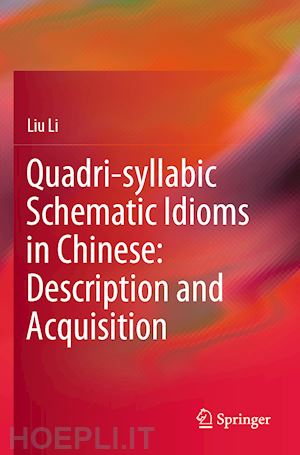
Questo prodotto usufruisce delle SPEDIZIONI GRATIS
selezionando l'opzione Corriere Veloce in fase di ordine.
Pagabile anche con Carta della cultura giovani e del merito, 18App Bonus Cultura e Carta del Docente
This book offers an insightful description of the productive behavior of four-character schematic idiomatic expressions (SIEs) in Mandarin and explores from a usage-based perspective the issue of how young learners acquire the partial productivity of these expressions. The beginning chapters contribute to a constructional understanding of the quadri-syllabic SIEs and an in-depth distributional analysis of three typical schematic patterns based on natural corpus data. The following chapters present detailed reports on four experimental studies to account for the factors that play significant roles in the learning process of SIEs from adolescence to adulthood. In the final chapter, the author concludes that acquisition of SIEs is as an interactive process shaped by input frequency, structural complexity, internal semantic relation, and chunking effect of open morphemes at different age levels.
These findings enrich current understandings on constructional idioms and the emergentist model in idiom learning with a cross-linguistic focus on Mandarin unique quadri-syllabic SIEs. Language teachers, researchers, and postgraduate students who are interested in studies of idiomaticity. Construction grammar and usage-based learning model will find this book sufficiently informative and intriguing.
Introduction
1.1 Schematic idioms
1.2 Research Significance
1.3 Organization of the Book
Chapter 2
From Idioms to Constructions
2.1 Studies on English Idioms
2.1.1 Traditional Non-compositional View
2.1.2 Compositional/Multidimentional View
2.1.3 Constructional View on Idiomaticity
2.1.3.1 Idioms as Constructions
2.1.3.2 Constructions as Basic Linguistic Unit
2.1.3.3 Features of Construction Grammar
2.1.3.4 Psychological Reality of Constructions in Language Processing
2.1.3.5 Schematic Idioms as Constructional Idioms
2.2 Studies on Chinese Idioms
2.2.1 Features of Chinese Idioms
2.2.1.1 Internal Structure of Chinese Idioms
2.2.1.2 Semantic Opacity of Chinese Idioms
2.2.1.3 Functions of Chinese Idioms
2.2.1.4 Weakness in Current Chinese Idiom Definitions
2.2.2 Studies on Chinese schematic idioms as Constructions
2.2.3 Redefining Chinese idioms
2.3 Summary
Chapter 3
Idiom Acquisition and Usage-Based
Language Learning Theory
3.1 Models on Idiom Representation
3.1.1 The Direct Access Model
3.1.2 The Compositional Model
3.2 Factors in L1 Idiom Comprehension
3.3 Empirical Studies on Chinese Idiom Learning
3.4 A Critique on Current Studies of Idiom Learning
3.5 Usage-based Language Learning Theory --- How Constructions are learned?
3.5.1Schematization and Entrenchment --- Item-based Learning
3.5.2Explanation on Overgeneralization---Entrenchment and Preemption
3.5.3Research Methods in Usage-based Model
3.5.4 Important Factors in Usage-based Model
3.5.4.1 Frequency
3.5.4.2 Complexity
3.5.4.3 Consistency
3.5.4.4 Age
3.6 Summary
Chapter 4
Chinese Schematic Idioms
---Productivity and Constraints
4.1 Semi-fixed Patterns in Chinese Idioms
4.2 Distributional Analysis of XAXB Construction
4.2.1 Types of Relations in Chinese Lexical Words
4.2.2 Features of the Fixed Morpheme X in XAXB Construction
4.2.3 Constraints on Open Morphemes A, B in XAXB construction
4.2.4 Case Study of bu-A-bu-B Schema
4.2.5 Interpretations of XAXB Construction and the Distributional Statistics
4.2.6 Statistical Distribution of XAXB Expressions
4.2.7 Senses of bu-A-bu-B Expressions and the Natural Distribution
4.2.8 Statistical Distribution of bu-A-bu-B Expression in Corpus
4.3 Distributional Analysis of XAYB and AXBY Constructions
4.3.1 Productivity of XAYB construction
4.3.2 Interpretations of XAYB and the statistical distribution
4.3.3 Statistical Distribution of XAYB Expressions in Corpus
4.3.4 Productivity of AXBY Construction
4.3.5 Interpretations of AXBY and the distributional statistics
4.3.6 ABs across the schemas
4.4 Summary of Distributional Analysis
4.5 Research Questions and Design
4.5.1 Research Questions
4.5.2 Age Factor
4.5.3 Instruments
4.5.4 A Summary of Experimental Studies
4.6 Summary
Chapter 5
Study One5.1 Experimental Design and Materials
5.2 Participants
5.3 Procedures
5.4 Scoring
5.5 Results of Study One
5.6 Discussions
Chapter 6
Study Two
6.1 Experimental Design and Materials
6.2 Participants
6.3 Procedure
6.4 Scoring
6.5 Results
6.6 Discussions on Study Two
Chapter 7
Study Three
7.1 Research Instrument
7.2 Design and Materials
7. 3 Participants
7.4 Materials and Procedure
7.5 Results of Study Three
7.6 Summary and Discussions of Study Three
Chapter 8
Study Four
8.1 Research Instrument
8.2 Design and materials
8.3 Participants
8.4 Procedure
8.5 Results of Study Four
8.6 Summary of Study Four
8.7 Summary of Four Experimental Studies
Chapter 9
Error Analysis in Sentence Production Tasks
9.1 Classification of Error Types
9.2 Overall Error Distribution in Sentence Productions
9. 2.1 Syntactic Restriction Violations
9.2.2 Semantic Restriction Violations
9.2.3 Sense Disagreement
9. 2.4 Incomplete Responses
9.3 Patterns in Error Type Distribution
9.4 Summary
Chapter 10
Discussion and Conclusion
10.1 General Results
10.2 Effects of Identified Factors
10.2.1 Input Frequency
10.2.2 Structural Complexity and Internal Semantic Relation
10.2.3 Chunk Selection of Open Morphemes
10.2.4 Age
10.3 Empirical Evidence of Schematic Idioms as Constructions
10.4 Representations of Schematic Idioms
10.4.1 Entrenchment, Schematization and Pre-emption
10.4.2 Emergentist Model on Idiom Learning
10.3.3 Whole-form Frequency Effect
10.4 Implications and limitations
10.5 Conclusion
References











Il sito utilizza cookie ed altri strumenti di tracciamento che raccolgono informazioni dal dispositivo dell’utente. Oltre ai cookie tecnici ed analitici aggregati, strettamente necessari per il funzionamento di questo sito web, previo consenso dell’utente possono essere installati cookie di profilazione e marketing e cookie dei social media. Cliccando su “Accetto tutti i cookie” saranno attivate tutte le categorie di cookie. Per accettare solo deterninate categorie di cookie, cliccare invece su “Impostazioni cookie”. Chiudendo il banner o continuando a navigare saranno installati solo cookie tecnici. Per maggiori dettagli, consultare la Cookie Policy.